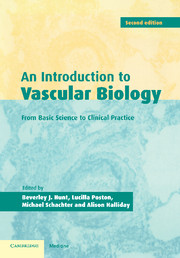Book contents
- Frontmatter
- Contents
- List of contributors
- Preface
- Part I Basic science
- Part II Pathophysiology: mechanisms and imaging
- Part III Clinical practice
- 12 Vascular biology of hypertension
- 13 Atherosclerosis
- 14 Abdominal aortic aneurysm
- 15 The vasculature in diabetes
- 16 The vasculitides
- 17 Pulmonary hypertension
- 18 Role of endothelial cells in transplant rejection
- 19 Vascular function in normal pregnancy and preeclampsia
- Index
12 - Vascular biology of hypertension
Published online by Cambridge University Press: 07 September 2009
- Frontmatter
- Contents
- List of contributors
- Preface
- Part I Basic science
- Part II Pathophysiology: mechanisms and imaging
- Part III Clinical practice
- 12 Vascular biology of hypertension
- 13 Atherosclerosis
- 14 Abdominal aortic aneurysm
- 15 The vasculature in diabetes
- 16 The vasculitides
- 17 Pulmonary hypertension
- 18 Role of endothelial cells in transplant rejection
- 19 Vascular function in normal pregnancy and preeclampsia
- Index
Summary
Introduction
What does the title of this chapter actually mean? It has to be said at the outset that it sounds more comprehensive than it can possibly be within the constraints of space and the reader's patience. In other words, it has to represent the author's selective interests and prejudices. In this case this will wholly exclude from consideration the role of large arteries and their mechanical properties, apart from one brief mention. Instead the focus will be on the following main questions:
• Is there endothelial dysfunction in hypertension?
– If so, what is its severity?
– How does it occur?
– Is it influenced and even corrected by antihypertensive drugs?
– Is this clinically important?
• What determines peripheral vascular resistance, especially in terms of the structure of the vessels concerned?
As one might expect, these are contentious issues despite, or rather because of, intensive research. The reader, as always, will have to make up his or her own mind and should note that in some cases reviews have been cited in order to keep the number of references within manageable limits.
Endothelial dysfunction in hypertension
Is there endothelial dysfunction in hypertension?
The dynamic nature of the endothelium is now very much a truism, though it would have surprised most vascular biologists 30 or even 20 years ago. Table 12.1 lists some of the vasoconstrictor and vasodilator substances produced by the endothelium. Though this list is likely to grow it is also probable that the most important factors have now been identified.
- Type
- Chapter
- Information
- An Introduction to Vascular BiologyFrom Basic Science to Clinical Practice, pp. 285 - 301Publisher: Cambridge University PressPrint publication year: 2002



